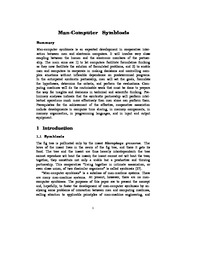Man-Computer SymbiosisJoseph C. R. Licklider
Erstpublikation in: IRE Transactions on Human Factors in Electronics, volume HFE-1, pages 4–11, March 1960.
Publikationsdatum:
|
 |
 Zusammenfassungen
Zusammenfassungen
Man-computer symbiosis is an expected development in cooperative interaction between men and electronic computers. It will involve very close coupling between the human and the electronic members of the partnership. The main aims are 1) to let computers facilitate formulative thinking as they now facilitate the solution of formulated problems, and 2) to enable men and computers to cooperate in making decisions and controlling complex situations without inflexible dependence on predetermined programs. In the anticipated symbiotic partnership, men will set the goals, formulate the hypotheses, determine the criteria, and perform the evaluations. Computing machines will do the routinizable work that must be done to prepare the way for insights and decisions in technical and scientific thinking. Preliminary analyses indicate that the symbiotic partnership will perform intellectual operations much more effectively than man alone can perform them. Prerequisites for the achievement of the effective, cooperative association include developments in computer time sharing, in memory components, in memory organization, in programming languages, and in input and output equipment.
Von Joseph C. R. Licklider im Text Man-Computer Symbiosis (1960)  Dieser wissenschaftliche Zeitschriftenartikel erwähnt ...
Dieser wissenschaftliche Zeitschriftenartikel erwähnt ...
 Dieser wissenschaftliche Zeitschriftenartikel erwähnt vermutlich nicht ...
Dieser wissenschaftliche Zeitschriftenartikel erwähnt vermutlich nicht ... 
 Nicht erwähnte Begriffe | blockbasierte Programmierumgebungen |
 Tagcloud
Tagcloud
 Zitationsgraph
Zitationsgraph
 Zitationsgraph (Beta-Test mit vis.js)
Zitationsgraph (Beta-Test mit vis.js)
 Zeitleiste
Zeitleiste
 11 Erwähnungen
11 Erwähnungen 
- The Dream Machine - J.C.R. Licklider and the Revolution That Made Computing Personal (M. Mitchell Waldrop) (2002)


- Wissenstransfer mit Wikis und Weblogs - Fallstudien zum Erfolgreichen Einsatz von Web 2.0 in Unternehmen (Alexander Stocker, Klaus Tochtermann) (2010)

- Human-Centered Computing - A New Degree for Licklider's World (Mark Guzdial) (2013)


- The Glass Cage - Automation and Us (Nicholas G. Carr) (2014)

- Great Principles of Computing (Peter Denning, Craig Martell) (2015)


- Cyber-Proletariat - Global Labour in the Digital Vortex (Nick Dyer-Witheford) (2015)

- Machines of Loving Grace - The Quest for Common Ground Between Humans and Robots (John Markoff) (2015)


- Coding Literacy - How Computer Programming Is Changing Writing (Annette Vee) (2017)

- Teaching Media - Medientheorie für die Schulpraxis - Grundlagen, Beispiele, Perspektiven (Elisabeth Kampmann, Gregor Schwering) (2017)


- Power and Progress - Our Thousand-Year Struggle Over Technology and Prosperity (Daron Acemoglu, Simon Johnson) (2023)

- The impact of generative artificial intelligence on socioeconomic inequalities and policymaking (Valerio Capraro, Austin Lentsch, Daron Acemoglu, Selin Akgun, Aisel Akhmedova, Ennio Bilancini, Jean-François Bonnefon, Pablo Brañas-Garza, Luigi Butera, Karen Douglas, Jim Everett, Gerd Gigerenzer, Christine Greenhow, Daniel Hashimoto, Julianne Holt-Lunstad, Jolanda Jetten, Simon Johnson, Werner Kunz, Chiara Longoni, Pete Lunn, Simone Natale, Stefanie Paluch, Iyad Rahwan, Neil Selwyn, Vivek Singh, Siddharth Suri, Jennifer Sutcliffe, Joe Tomlinson, Sander van der Linden, Paul Van Lange, Friederike Wall, Jay Van Bavel, Riccardo Viale) (2024)


 Volltext dieses Dokuments
Volltext dieses Dokuments
 |  Man-Computer Symbiosis: Artikel als Volltext ( Man-Computer Symbiosis: Artikel als Volltext ( : :  , 43 kByte; , 43 kByte;  : :  2020-11-28) 2020-11-28) |
 Anderswo suchen
Anderswo suchen 
 Beat und dieser wissenschaftliche Zeitschriftenartikel
Beat und dieser wissenschaftliche Zeitschriftenartikel
Beat hat Dieser wissenschaftliche Zeitschriftenartikel während seiner Zeit am Institut für Medien und Schule (IMS) ins Biblionetz aufgenommen. Beat besitzt kein physisches, aber ein digitales Exemplar. Eine digitale Version ist auf dem Internet verfügbar (s.o.).









 Computer
Computer Denken
Denken Geometrie
Geometrie Intelligenz
Intelligenz Künstliche Intelligenz (KI / AI)
Künstliche Intelligenz (KI / AI) Programmieren
Programmieren Sprache
Sprache Biblionetz-History
Biblionetz-History